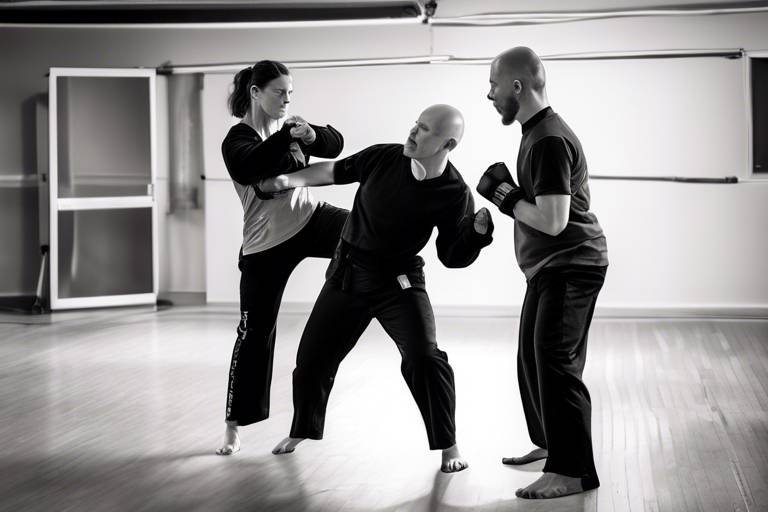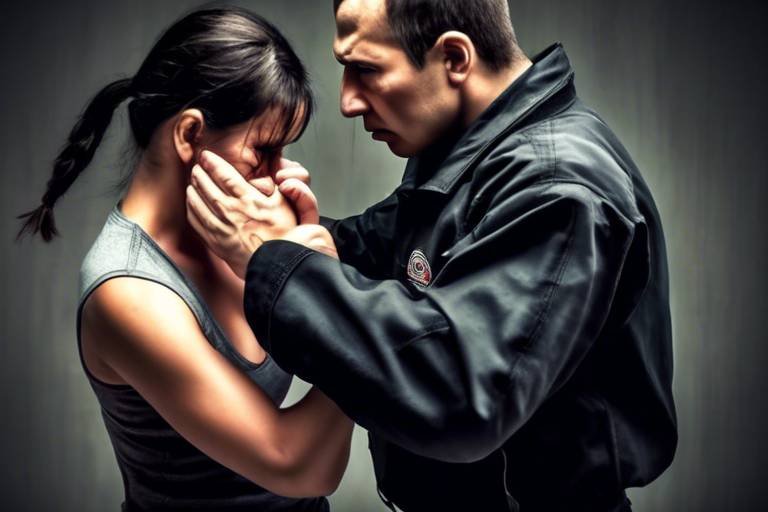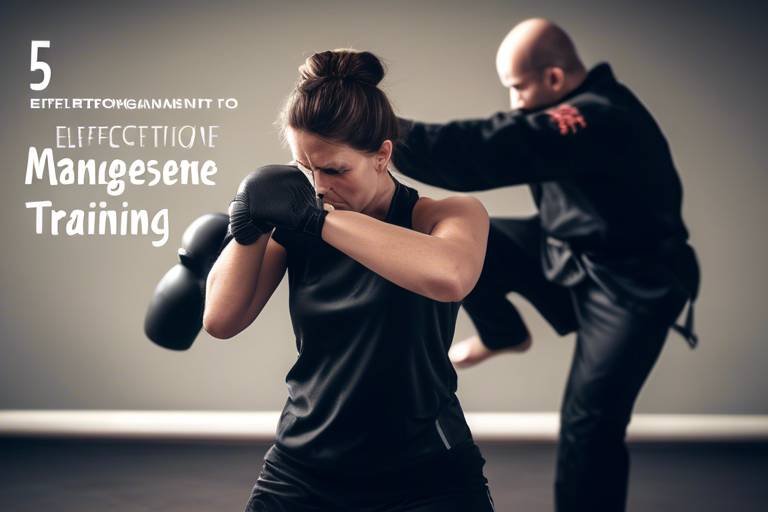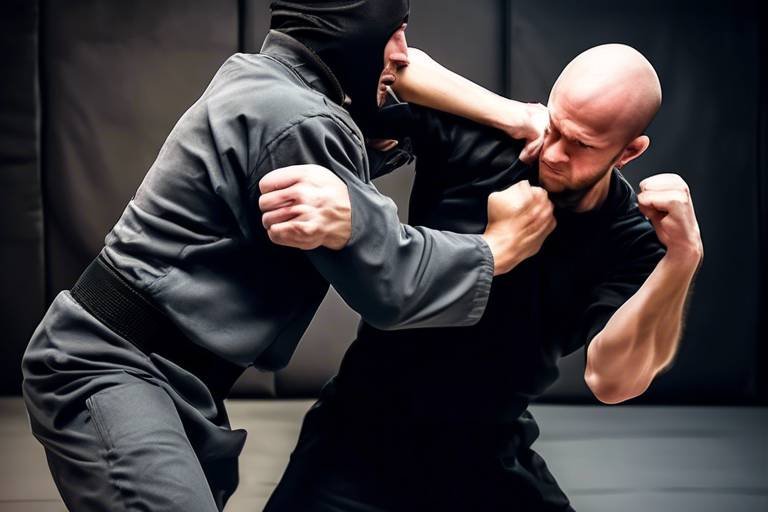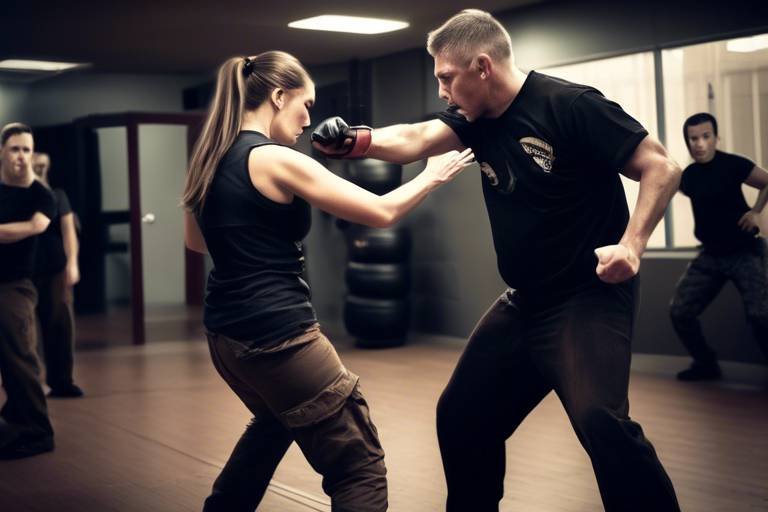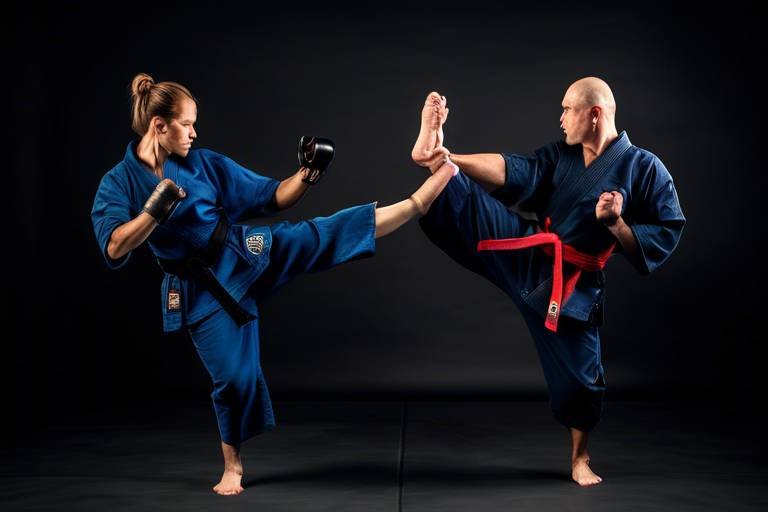Self-Defense Techniques: How Much Force should You Use?
Self-defense is a topic that often stirs up intense emotions and debates. It’s not just about physical confrontation; it’s about understanding the principles that govern our actions when faced with a threat. When we talk about self-defense techniques, the question of how much force to use becomes paramount. After all, the right amount of force can mean the difference between protecting yourself and facing legal repercussions. So, how do we navigate this complex landscape? Let’s dive deeper into the principles of self-defense and the nuances involved in determining the appropriate level of force.
At its core, self-defense is a legal concept that allows individuals to use reasonable force to protect themselves from imminent harm. This principle is rooted in the idea that everyone has the right to safeguard their own life and well-being. However, what constitutes “reasonable force” can vary significantly from one situation to another and from one jurisdiction to another. Understanding the foundational principles and legal definitions surrounding self-defense is crucial for anyone interested in personal safety.
When it comes to self-defense, assessing the right amount of force is not just important; it’s essential. Imagine walking down the street and suddenly being confronted by an aggressive individual. Your instinct may be to react quickly, but how do you know how much force is appropriate? Several factors influence this decision, including the nature of the threat, the surrounding circumstances, and your own physical capabilities. In the heat of the moment, these considerations can be challenging to navigate.
Evaluating the nature and immediacy of a threat is vital for determining how much force to use. A common analogy is that of a fire alarm: if you hear a faint beep, you might check the batteries, but if the alarm is blaring, you know it’s time to act decisively. Similarly, in self-defense scenarios, understanding the level of threat can guide your response. Techniques for effective threat assessment can include:
- Observing body language and behavior of the aggressor.
- Assessing the environment and potential escape routes.
- Listening to verbal cues that may indicate intent.
Not all threats are created equal. Understanding different types of threats can help individuals respond appropriately. For instance, verbal aggression, while unsettling, may not necessitate the same level of force as a physical attack. Here’s a quick breakdown:
| Type of Threat | Response |
|---|---|
| Verbal Aggression | De-escalation techniques |
| Physical Attack | Use of physical self-defense techniques |
| Imminent Danger | Maximum force necessary to escape |
Being aware of your surroundings can significantly impact self-defense decisions. Think of it as being a hawk soaring above the landscape, keenly observing every detail. Enhancing your situational awareness involves actively scanning your environment and recognizing potential threats before they escalate. Here are some tips to improve your situational awareness:
- Stay off your phone and focus on your surroundings.
- Trust your instincts; if something feels off, it probably is.
- Practice mindfulness to stay present in the moment.
The legal implications of using force in self-defense can be as complex as a legal thriller novel. Laws vary widely by jurisdiction, and understanding local laws is crucial. For instance, some places have “stand your ground” laws, while others require a duty to retreat before using force. Familiarizing yourself with these legal concepts can help you make informed decisions in high-pressure situations.
Now that we have a foundational understanding of the principles of self-defense, let’s explore various techniques suitable for different situations. The key here is to apply force appropriately while ensuring your personal safety. Self-defense is not about being a martial arts expert; it’s about knowing how to protect yourself effectively.
Physical self-defense techniques can range from simple strikes to advanced holds. The goal is to incapacitate the aggressor long enough to escape. However, it’s crucial to consider the level of force required. A well-placed palm strike may be enough to create distance, whereas a more aggressive attack may require a different approach. Always remember, the objective is to protect yourself, not to escalate the situation unnecessarily.
On the flip side, verbal skills can often prevent physical confrontations altogether. In many cases, a calm and assertive voice can diffuse a tense situation. Techniques for de-escalating potentially violent situations include:
- Using a calm tone to communicate.
- Empathizing with the aggressor’s feelings.
- Setting clear boundaries without being confrontational.
Q: What is the legal definition of self-defense?
A: Self-defense is legally defined as the right to use reasonable force to protect oneself from imminent harm. The definition can vary by jurisdiction.
Q: How do I know how much force to use?
A: The amount of force used in self-defense should be proportional to the threat faced. Assess the situation carefully and consider factors like the aggressor's behavior and your own safety.
Q: Can verbal de-escalation really work?
A: Yes! Many conflicts can be resolved through effective communication. Staying calm and assertive can often prevent physical confrontations.

Understanding Self-Defense
Self-defense is not just a physical reaction; it’s a legal concept that allows individuals to protect themselves from harm using reasonable force. Imagine walking down a dimly lit street when suddenly you feel threatened by someone approaching you. In that moment, understanding the principles of self-defense can mean the difference between safety and danger. It's essential to grasp the foundational aspects of self-defense, as it encompasses not only the actions you can take but also the legal ramifications that come with those actions.
At its core, self-defense is about the right to protect oneself from imminent danger. This right is recognized in many legal systems around the world, but the specifics can vary significantly from one jurisdiction to another. For instance, the level of force considered "reasonable" can differ based on local laws. In some areas, even a slight physical response can be viewed as excessive, while in others, a more aggressive reaction may be justified. This inconsistency can lead to confusion and, unfortunately, legal trouble for those who act in self-defense without a proper understanding of the law.
To navigate the complexities of self-defense, it's crucial to understand the following key principles:
- Immediacy of Threat: The threat must be immediate. If the danger has passed, any force used could be deemed unnecessary.
- Proportionality: The level of force used in self-defense must be proportional to the threat faced. For example, responding to a verbal threat with physical violence may not be justified.
- Retreat: In some jurisdictions, individuals are required to retreat from a threat if it is safe to do so before resorting to force.
Understanding these principles can help individuals make informed decisions in high-pressure situations. It’s not just about what you can do; it’s about what you should do to ensure your safety without crossing legal boundaries. The goal is to protect yourself while minimizing harm to others and avoiding legal consequences.
Moreover, self-defense is not solely about physical confrontation. It also involves mental preparedness and the ability to assess situations critically. This means being aware of your surroundings and recognizing potential threats before they escalate. In this way, self-defense becomes a holistic approach to personal safety, integrating both physical and psychological elements.
In summary, understanding self-defense is essential for anyone who wants to feel empowered in potentially dangerous situations. It’s about knowing your rights, recognizing the appropriate level of force, and being prepared to act decisively and legally. As we delve deeper into this topic, we will explore how to assess threats, the legal considerations involved, and the techniques that can help keep you safe.

Determining the Appropriate Level of Force
When it comes to self-defense, one of the most critical aspects to consider is the appropriate level of force to use. It's not just about protecting yourself; it's also about ensuring that your response is justified and legal. Imagine you’re in a situation where someone is threatening you. Your instincts may kick in, urging you to fight back with everything you’ve got. However, using excessive force can lead to serious legal repercussions. So, how do you navigate this tricky terrain?
First and foremost, understanding the context of the threat is essential. The level of force you choose to employ should be proportional to the threat you are facing. For instance, if someone is merely shouting at you and making threats, responding with physical violence may not only be unnecessary but could also escalate the situation dramatically. On the other hand, if you are faced with an imminent physical attack, a more assertive response may be warranted. The key is to assess the situation carefully.
Several factors influence your decision-making process regarding the level of force:
- Immediacy of the Threat: Is the threat happening right now, or is it a potential future threat?
- Nature of the Attack: Is it verbal, physical, or both? Understanding the type of aggression can help you decide how to respond.
- Surrounding Environment: Are there bystanders? Are you in a confined space? The environment can impact your options.
- Your Personal Safety: Your ability to escape the situation can also dictate the level of force you should use.
Furthermore, it’s crucial to remember that self-defense laws vary significantly between jurisdictions. In some areas, the law allows for a broader range of responses, while in others, the use of force is strictly regulated. Therefore, familiarizing yourself with local laws is not just a good idea; it’s a necessity. Knowing the legal boundaries can help you make informed decisions in high-pressure situations.
In addition to understanding the legal implications, you should also consider the consequences of your actions. Even if you are justified in using force, the aftermath can be complicated. You may face legal battles, emotional distress, and even social repercussions. This is why it’s essential to think critically about your response and aim for the least amount of force necessary to ensure your safety.
In summary, determining the appropriate level of force in self-defense situations is a nuanced process that requires careful consideration of various factors. Assessing the threat, understanding the legal landscape, and weighing the potential consequences are all critical components of making a responsible decision. Remember, the goal of self-defense is not to inflict harm but to protect yourself and de-escalate the situation whenever possible.
- What is the legal definition of self-defense? Self-defense is a legal concept that allows individuals to use reasonable force to protect themselves from imminent harm.
- How do I know if my response is justified? Your response should be proportional to the threat you face, and it's essential to understand local laws regarding self-defense.
- Can verbal threats justify physical retaliation? Generally, verbal threats alone do not justify physical force; the response should match the immediacy and nature of the threat.
- What should I do after a self-defense incident? Seek legal advice and ensure your safety first. Document the incident and gather any witnesses if possible.

Threat Assessment
When it comes to self-defense, the first step is often the most crucial: assessing the threat. Think of it as a game of chess; every move counts and can change the outcome of the entire match. In self-defense scenarios, understanding the nature and immediacy of a threat can be the difference between a safe escape and a dangerous confrontation. So, how do you evaluate a threat effectively? Let’s dive into some key considerations.
First off, situational awareness is your best friend. This means being attuned to your surroundings, recognizing potential dangers before they escalate. Are there people around you? What are their behaviors? Is there an exit nearby? By asking these questions, you can gauge whether you’re in a safe environment or if you need to be on high alert. Remember, threats can manifest in various forms, from someone aggressively approaching you to a group of individuals loitering suspiciously. Each scenario requires a different level of vigilance.
Next, it’s essential to discern the type of threat you’re facing. There are several categories of threats that can influence your response:
- Verbal Aggression: Words can cut deep, but they often don’t warrant a physical response. If someone is yelling at you or making threats, your first instinct might be to defend yourself. However, it’s crucial to weigh the situation and determine if physical action is necessary or if you can walk away.
- Physical Attacks: This is where things get serious. If someone is physically assaulting you, the level of force you use in response must be proportional to the threat. Remember, your goal is to neutralize the threat and escape, not to inflict unnecessary harm.
- Implied Threats: Sometimes, a threat isn’t overt. Body language can say a lot; if someone is approaching you with clenched fists or an aggressive stance, they may be preparing to attack. Recognizing these cues early can help you react appropriately.
Another vital aspect of threat assessment is understanding the context of the situation. For instance, are you in a crowded area or a secluded place? The presence of witnesses can impact the dynamics of a confrontation. In a crowded space, an attacker might be less likely to escalate violence due to the fear of getting caught. Conversely, in a secluded area, the threat may be more pronounced, requiring a more immediate response.
To effectively assess a threat, consider employing the OODA loop strategy, which stands for Observe, Orient, Decide, and Act. This tactical approach helps you make quick decisions based on your observations:
| Step | Description |
|---|---|
| Observe | Take in your surroundings and identify potential threats. |
| Orient | Analyze the information you’ve gathered and determine the nature of the threat. |
| Decide | Choose the best course of action based on your assessment. |
| Act | Implement your decision, whether it’s to escape, de-escalate, or defend yourself. |
In conclusion, threat assessment is an ongoing process that requires keen observation and quick thinking. By honing your ability to evaluate threats, you empower yourself to react appropriately, ensuring your safety while minimizing unnecessary conflict. Remember, the goal of self-defense is not to engage in violence but to protect yourself and find a safe exit from a potentially harmful situation.

Types of Threats
When it comes to self-defense, understanding the you might encounter is crucial for making informed decisions about your response. Not all threats are created equal, and recognizing the nuances can help you determine the appropriate level of force to use. Generally, threats can be categorized into two broad types: verbal threats and physical threats.
Verbal threats often manifest in situations where someone uses aggressive language, intimidation, or harassment to instill fear. While these encounters can be distressing, it's essential to evaluate whether the threat is likely to escalate into physical violence. In many cases, responding to verbal aggression with calmness and assertiveness can de-escalate the situation without resorting to physical confrontation. For instance, using a firm but non-threatening tone can sometimes diffuse a tense interaction before it spirals out of control.
On the other hand, physical threats involve direct harm or the imminent possibility of being harmed. This category includes a range of situations, from someone attempting to push you or grab your belongings to more severe attacks involving weapons. Here, the level of force you might need to employ is often dictated by the immediacy and severity of the threat. For example, if someone is physically attacking you, defending yourself may require a more robust response compared to a situation where someone is merely invading your personal space.
To better illustrate these types of threats, consider the following table:
| Type of Threat | Description | Recommended Response |
|---|---|---|
| Verbal Threats | Aggressive language or intimidation without physical contact. | Calm de-escalation techniques, assertive communication. |
| Physical Threats | Imminent danger of physical harm or attack. | Self-defense techniques, escape if possible. |
It's also important to note that some threats can be ambiguous. For instance, a person may approach you aggressively but may not necessarily intend to harm you. In such cases, maintaining situational awareness and being prepared to respond can make all the difference. Remember, your safety is paramount, and knowing how to assess the type of threat can help you navigate these situations more effectively.
In summary, recognizing the type of threat you are facing—whether verbal or physical—can significantly influence your self-defense strategy. By understanding these distinctions, you are better equipped to respond appropriately, ensuring your safety while minimizing unnecessary escalation.
- What should I do if I encounter a verbal threat? - Stay calm, assess the situation, and use verbal de-escalation techniques.
- How can I tell if a physical threat is imminent? - Look for aggressive body language, proximity, and any signs of intent to harm.
- Is it legal to respond physically to a verbal threat? - Laws vary by jurisdiction; it's essential to know local laws regarding self-defense.

Situational Awareness
Situational awareness is your first line of defense in any potential confrontation. It’s like being a hawk in a field full of rabbits; you need to be alert, observant, and ready to react. Imagine walking into a crowded area, the hustle and bustle around you. Instead of getting lost in your phone or daydreaming, you should be scanning your environment, noticing who is around you and what they are doing. This proactive approach can make all the difference in your safety.
To enhance your situational awareness, consider the following strategies:
- Observe your surroundings: Take a moment to look around and identify exits, potential hazards, and the people nearby. Are there any individuals acting suspiciously? Is there a group that seems overly aggressive?
- Trust your instincts: If something feels off, it probably is. Your gut feeling is a powerful tool. Don’t ignore it; instead, take precautionary measures.
- Stay focused: Avoid distractions such as your phone or loud music when in unfamiliar or crowded places. Maintaining focus allows you to pick up on subtle cues that could indicate a threat.
Think of situational awareness as a radar system. Just like radar detects incoming objects, your awareness can help you anticipate and react to potential dangers. It’s not about being paranoid; it’s about being prepared. By regularly practicing these techniques, you can train yourself to be more alert and responsive to your environment.
Moreover, situational awareness extends beyond just recognizing threats. It involves understanding the dynamics of your environment. For instance, if you’re in a bar and notice a heated argument escalating, your awareness allows you to either leave the situation or prepare to defend yourself if necessary. This holistic understanding of your surroundings can empower you to make smarter decisions, whether that means walking away from a potential fight or preparing yourself for a defensive action.
Incorporating situational awareness into your daily life can be transformative. It’s not just a self-defense tactic; it’s a valuable life skill. Whether you’re walking down a street, attending a social event, or even just hanging out at home, being aware of your surroundings can help you avoid dangerous situations before they escalate. Remember, the goal is to *avoid conflict* whenever possible, and being aware of what’s happening around you is one of the best ways to do that.
- What is situational awareness?
Situational awareness is the ability to identify, process, and comprehend information about your surroundings to make informed decisions, especially in potentially dangerous situations.
- How can I improve my situational awareness?
You can improve your situational awareness by practicing observation, minimizing distractions, trusting your instincts, and regularly assessing your environment.
- Is situational awareness only important for self-defense?
No, situational awareness is beneficial in various situations, including driving, navigating social settings, and even at work, as it helps you make better decisions.

Legal Considerations
When it comes to self-defense, the legal landscape can be as intricate as a spider's web. Understanding the laws that govern the use of force is crucial because these laws can vary significantly from one jurisdiction to another. For instance, what might be considered reasonable self-defense in one state could land you in hot water in another. It’s essential to grasp the fundamental legal principles surrounding self-defense to navigate these murky waters effectively.
At its core, self-defense laws are designed to allow individuals to protect themselves from imminent harm. However, the key word here is reasonable. This means that the force used must be proportional to the threat faced. If someone is merely verbally aggressive, responding with physical violence could be deemed excessive and lead to serious legal consequences. On the flip side, if someone is attacking you with a weapon, a more forceful response may be justified.
Here are some important legal concepts to keep in mind:
- Imminence: The threat must be immediate. If the danger has passed, the right to defend oneself diminishes.
- Proportionality: The force used in self-defense must match the level of threat. Using a hammer to defend against a verbal insult is likely to be seen as disproportionate.
- Duty to Retreat: In some jurisdictions, individuals are required to retreat from a threat if it’s safe to do so before resorting to force. However, this is not the case in “stand your ground” states.
It’s also worth noting that self-defense laws often include a provision for defense of others. If you witness someone else being attacked, you may have the right to intervene and protect them, but again, the force used must be reasonable and proportional to the threat faced by that person.
Legal definitions and interpretations can be complicated, so it’s wise to familiarize yourself with the laws in your area. Consulting with a legal expert or taking a self-defense class that covers legal aspects can provide valuable insights and prepare you for any unexpected situations.
In conclusion, understanding the legal considerations surrounding self-defense is not just about knowing your rights; it’s about being prepared to act within the law. The consequences of misjudging a situation can be severe, leading to criminal charges or civil liabilities. Therefore, always be mindful of the laws applicable in your jurisdiction and seek guidance when necessary.
Here are some common questions people have regarding legal considerations in self-defense:
- What constitutes reasonable force? Reasonable force is the minimum amount of force necessary to prevent harm. It varies based on the situation.
- Do I have to retreat before using force? It depends on the laws in your jurisdiction. Some places require a duty to retreat, while others allow you to stand your ground.
- Can I use self-defense if I started the fight? Generally, if you instigate a confrontation, you may not be able to claim self-defense unless you withdraw and the other party continues to attack.

Self-Defense Techniques
When it comes to self-defense, knowing the right techniques can be a game-changer. It's not just about brute strength; it's about using your body wisely and effectively. Imagine being in a situation where you feel threatened. Your heart races, your palms sweat, and your mind is racing with thoughts of how to protect yourself. In these moments, having a few self-defense techniques up your sleeve can make all the difference. But what does it really mean to defend yourself? It means understanding how to apply the appropriate level of force while ensuring your own safety.
There are several self-defense techniques that cater to different scenarios, and each technique has its own set of principles. For instance, physical techniques such as strikes, holds, and escapes can be incredibly effective when executed correctly. However, the key lies in knowing how much force is necessary. You wouldn’t use a sledgehammer to crack a nut, right? Similarly, using excessive force in a minor confrontation can lead to serious legal repercussions. The goal of self-defense is to protect yourself, not to escalate the situation unnecessarily.
In addition to physical techniques, verbal de-escalation plays a crucial role in self-defense. Often, a well-placed word or a calm demeanor can diffuse a potentially dangerous situation before it even escalates to physical confrontation. Think of it as a fire extinguisher for conflict; sometimes, all it takes is a gentle word to put out the flames of aggression. Techniques such as active listening, maintaining a non-threatening posture, and using a calm tone can go a long way in preventing violence.
It's also important to recognize the context in which you might need to use these techniques. For example, if you find yourself facing a verbal aggressor, your response will differ significantly from that of a physical attacker. Understanding the nature of the threat can help you choose the right approach. Here are a few self-defense techniques you might consider:
- Strikes: Quick and effective, strikes can include punches, kicks, or elbow strikes aimed at vulnerable areas.
- Holds: Techniques like wrist locks or bear hugs can immobilize an attacker without causing unnecessary harm.
- Escapes: Learning how to break free from holds can be crucial if you're caught off guard.
Practicing these techniques regularly can enhance your confidence and readiness. Just like learning to ride a bike, the more you practice, the more instinctive your reactions will become. Consider enrolling in a self-defense class or martial arts training to refine your skills. Not only will you learn how to protect yourself, but you will also gain valuable insights into the psychology of conflict and how to manage it effectively.
Finally, remember that self-defense is not just about physical techniques. It's a mindset. Being aware of your surroundings, trusting your instincts, and knowing when to walk away can often be the best defense. So, gear up, stay informed, and empower yourself with the knowledge and skills to protect what matters most—your safety.
Q: What is the most effective self-defense technique?
A: The most effective technique varies based on the situation, but a combination of physical techniques and verbal de-escalation strategies often works best.
Q: Is it legal to use self-defense techniques?
A: Yes, self-defense is legal, but the level of force used must be reasonable and proportional to the threat faced.
Q: How can I improve my situational awareness?
A: Regularly practice being mindful of your surroundings, engage in activities that require focus, and learn to recognize potential threats.

Physical Techniques
When it comes to self-defense, understanding can be a game changer. It’s not just about throwing punches or grappling; it's about knowing how to apply the right amount of force effectively and responsibly. Imagine being backed into a corner, heart racing, and your instincts kicking in. In that moment, you need to know exactly how to react. That’s where these techniques come into play. They are designed to help you protect yourself while minimizing harm to both you and your attacker.
First and foremost, let’s talk about the types of strikes you can use. Strikes can range from simple open-hand techniques to more complex punches. The key is to aim for vulnerable areas of the body, such as the eyes, throat, or groin. These spots are sensitive and can incapacitate an attacker quickly, allowing you to escape. However, it’s crucial to remember that the force you use should be proportional to the threat you are facing. For example, if someone is merely trying to intimidate you verbally, a strong physical response may not only be unnecessary but could also escalate the situation.
Another important aspect of physical self-defense is the use of holds and joint locks. These techniques allow you to control an assailant without resorting to excessive force. For instance, a wrist lock can effectively immobilize someone, giving you the chance to get away. However, executing these techniques requires practice and precision. You wouldn’t want to accidentally cause serious injury when your goal is merely to escape a dangerous situation. Therefore, training in proper technique is essential.
To further illustrate the importance of technique, consider the following table that outlines various physical self-defense techniques and their appropriate applications:
| Technique | Application | Force Level |
|---|---|---|
| Open-Hand Strike | To distract or push away an attacker | Low |
| Punch | To incapacitate an attacker | Moderate |
| Wrist Lock | To control an assailant | Low to Moderate |
| Elbow Strike | To create distance | Moderate |
In addition to strikes and holds, it’s essential to incorporate movement into your physical self-defense strategy. Being able to evade an attack is just as important as knowing how to strike back. Techniques such as sidestepping or pivoting can help you avoid a confrontation altogether. Think of it like dancing; the more fluid and aware you are of your movements, the less likely you are to get caught up in a dangerous situation.
Lastly, practice is key. The more you train, the more instinctive these techniques will become. Consider enrolling in a self-defense class or joining a martial arts program. Not only will you learn valuable skills, but you’ll also gain confidence in your ability to protect yourself. Remember, self-defense is not just about the physical techniques; it’s about understanding how to assess a situation and respond appropriately.
- What is the best self-defense technique for beginners?
For beginners, open-hand strikes and basic evasion techniques are highly recommended. They are simple to learn and effective in many situations. - How can I practice self-defense at home?
You can practice self-defense techniques at home by shadowboxing, practicing movements in front of a mirror, or using a punching bag if you have one. - Is self-defense training worth it?
Absolutely! Self-defense training not only equips you with vital skills but also boosts your confidence and situational awareness.

Verbal De-escalation
When it comes to self-defense, one of the most powerful tools you have at your disposal is your ability to communicate. is the art of using words to diffuse a potentially violent situation before it escalates into a physical confrontation. Imagine walking into a bar where tensions are high, and you can feel the electricity in the air. Instead of jumping in fists-first, consider how a few well-chosen words could turn the tide. This technique is not just about avoiding a fight; it’s about using your voice as a shield to protect yourself and others.
So, how do you master the skill of verbal de-escalation? First, it’s essential to understand the psychology behind conflict. People often escalate situations when they feel threatened, misunderstood, or cornered. By recognizing these triggers, you can tailor your approach to address the underlying emotions. Here are some key strategies to keep in mind:
- Stay Calm: Your demeanor sets the tone. If you remain composed, it can help the other person relax.
- Listen Actively: Sometimes, people just want to be heard. Show empathy and validate their feelings.
- Use Open Body Language: Non-verbal cues are just as important as words. Keep your posture open and non-threatening.
- Avoid Provocation: Steer clear of inflammatory language or gestures that could escalate the situation.
These techniques can be incredibly effective, but they require practice and awareness. Think of it like learning to ride a bike; at first, you might wobble and fall, but with time, you’ll find your balance. Role-playing scenarios with friends or family can help you develop your verbal skills in a safe environment. You can even create a list of phrases that you find effective in calming others down, so you have a mental toolkit ready for when tensions rise.
Moreover, understanding the context is crucial. Are you facing someone who is verbally aggressive, or is it a situation where physical threat is imminent? In such cases, your approach might differ. For instance, if someone is shouting obscenities at you, responding with anger will likely escalate the situation. Instead, try to defuse their anger by acknowledging their feelings and offering a solution or compromise.
In summary, verbal de-escalation is a vital self-defense technique that can prevent physical confrontations. By utilizing calm communication, active listening, and appropriate body language, you can turn a potentially dangerous situation into a manageable one. Remember, the goal is not just to protect yourself but also to restore peace. With practice, you can become adept at navigating these tense moments with grace and confidence.
Q: What is verbal de-escalation?
A: Verbal de-escalation is a technique used to diffuse potentially violent situations through calm and effective communication.
Q: When should I use verbal de-escalation?
A: Use verbal de-escalation when you sense that a situation is becoming tense or aggressive, and you want to prevent it from escalating into violence.
Q: Can verbal de-escalation work in all situations?
A: While it can be effective in many scenarios, it may not work with individuals who are highly agitated or under the influence of substances. In such cases, prioritizing your safety is crucial.
Q: How can I improve my verbal de-escalation skills?
A: Practice active listening, role-play different scenarios, and develop a repertoire of calming phrases to use in tense situations.
Frequently Asked Questions
- What is self-defense?
Self-defense is a legal right that allows individuals to protect themselves from harm using reasonable force. It’s essential to understand that the level of force used must be proportional to the threat faced.
- How do I determine the appropriate level of force in a self-defense situation?
Determining the right amount of force involves assessing the threat level and the circumstances surrounding the encounter. Factors like the aggressor's behavior, the presence of weapons, and your own ability to escape play a crucial role in this decision.
- What types of threats should I be aware of?
Threats can vary widely, from verbal aggression to physical attacks. Understanding the nature of these threats helps you respond appropriately. For instance, a verbal threat may require a different response than a physical one.
- How can I enhance my situational awareness?
Improving situational awareness involves being mindful of your surroundings. This can be achieved by regularly scanning your environment, recognizing potential threats, and being alert to unusual behavior. Practicing mindfulness can also sharpen your focus.
- What legal considerations should I keep in mind regarding self-defense?
The legal implications of using force in self-defense are complex and can vary by location. It’s vital to be familiar with local laws regarding self-defense to ensure that your actions remain within legal boundaries.
- What are some effective self-defense techniques?
Effective self-defense techniques include physical methods like strikes and holds, as well as verbal de-escalation strategies. Knowing when and how to apply these techniques can significantly enhance your safety in threatening situations.
- Can verbal de-escalation really prevent a physical confrontation?
Absolutely! Verbal de-escalation techniques can often diffuse a potentially violent situation before it escalates. Using calm, assertive communication can help to lower tensions and prevent conflict.








